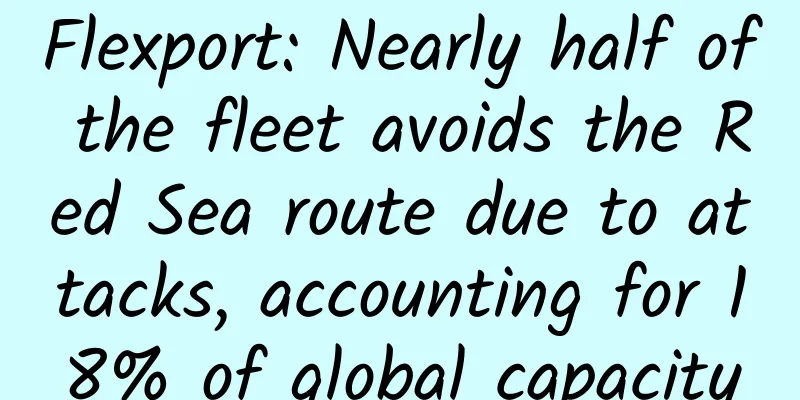Flexport: Nearly half of the fleet avoids the Red Sea route due to attacks, accounting for 18% of global capacity

|
The latest industry data shows that half of the container fleet that currently regularly passes through the Red Sea and the Suez Canal is avoiding the route due to the threat of attack. Flexport statistics show that a total of 299 ships that can carry 4.3 million containers have either changed their routes or plan to change their routes. This is about double the number a week ago, equivalent to about 18% of global capacity. Data shows that trips around Africa can take 25% longer than using the Suez Canal, which connects Asia and Europe. These routes are more expensive and could lead to higher prices for consumers on everything from sneakers to food to oil if the long-distance routes persist. The Red Sea attacks were carried out by Yemen's Houthi rebels, who said they were targeting ships with ties to Israel in support of the Palestinians. But ships not directly linked to Israel have also been targeted, and a U.S.-led task force is trying to bolster security in the crucial waterway as an escalating war threatens global trade. Some ships have sought to demonstrate their neutrality while continuing to use the route. Three ships — two container ships and a tanker — are currently transiting the waterway and signaling they have no connection with Israel, according to ship tracking data from TankerTrackers. All three ships have previously visited Russia. The trend in Flexport’s data mirrors another statistic from Swiss freight forwarder Kuehne and Nagel International AG, which showed 364 vessels with a capacity of 5 million twenty-foot containers were being rerouted around Africa as of Wednesday. That compares with 314 vessels on Dec. 22. The figures show the growing scale of chaos at sea after the Houthis launched more than 100 attacks on commercial vessels in the past month. The MSC United VIII container ship was attacked on Tuesday while en route from Saudi Arabia to Pakistan. As of Wednesday, 15 container ships, 10 of which are operated by A.P. Moller-Maersk A/S, had either remained on course or recently abandoned plans to reroute in order to cross the Red Sea to Suez, according to a Flexport analysis of Alphaliner data. Maersk, the world's second-largest container shipping line, said it was preparing to resume Red Sea routes "as soon as possible," while Hapag-Lloyd said it would keep its ships away from the region even after a U.S.-led task force is launched to protect key trade routes from militants. Data released on Thursday by Clarksons Research showed that the number of tourists entering the Gulf of Aden fell 40% between December 22 and 26 compared with the average level in the first half of the month. The number of container ships arriving at the port decreased by 87%, the number of oil tankers decreased by about 30%, and the number of car carriers decreased by about 25%. Transit traffic through the Suez Canal was similar, with southbound vessels down about 45% between Dec. 22 and 26, according to Clarksons. Daily transits of oil tankers and cargo ships through the Suez Canal have fallen this month A rerouting off the southern tip of Africa has expanded shipping capacity and raised freight rates. Flexport said the Suez Canal diversion and drought have restricted maritime traffic through the Panama Canal, with a worst-case scenario of a 20% reduction in global capacity. While the U.S. and its partners have successfully intercepted most of these attacks, the defensive strategy is costly and the risks are still driving up shipping insurance premiums, said geoeconomic analyst Gerard DiPippo. “While the U.S.-led coalition may appear successful militarily, this may not be enough to restore Red Sea transit by major shipping lines,” DiPippo said. “The longer the Houthi attacks continue, the more pressure there will be on the U.S. to attack, which could lead to regional escalation.” For companies with cargo on the diverted ships, efforts are underway to track new arrival times. “This is happening with every ship that’s been rerouted,” said Flexport founder and CEO Steve Schmidt. “The team is working overtime right now to try to keep up with this.” |
>>: Eurostat: 66% of EU Internet users will use online banking services in 2022
Recommend
What have 3.9 billion women gone through to achieve "menstrual freedom"?
In addition to sanitary napkins, modern women'...
Human "Death" Diary: Can a tiny insect kill people?
Source of this article: Knowledge Keer. Reprint p...
Is there a "correct order" for bathing? 10 bathing taboos when the weather gets cold, you must know!
Now that the weather is getting colder, there are...
Brown spots on underwear after menstruation
Normal menstruation usually lasts about 3 to 7 da...
The efficacy and function of eggplant flowers
Traditional Chinese medicine is very helpful in t...
The efficacy and function of Niuziqi
Do you know Niuziqi? It is a common Chinese medic...
Black-headed gull: Don’t call me the “king of eating”, I am the “wisest” among birds
Dear family, let's meet the black-headed gull...
After eating Houttuynia cordata once, I realized the cruelty of nature.
Legend has it that before the first pioneer who p...
The efficacy and function of Lulang Chicken
Lulang chicken, a traditional Chinese medicine, i...
What to do if you overdose on cough syrup
Cough syrup is not unfamiliar to many people, and...
The efficacy and function of Amomum villosum shell
Do you know about Amomum villosum shell? It is a ...
We have clearly seen the evolution from single cells to humans, so why do people still say that biological evolution has no direction?
The day before yesterday, we happened to talk abo...
Buckwheat straw benefits and effects
Buckwheat straw is a traditional Chinese medicina...
There are 4 Guineas in the world. Can you tell which coup is which?
This article was first published by Hunzhi (WeCha...
Let’s celebrate the birthday of “π” together on March 14! How much do you know about pi?
Today is International Pi Day, and also Internati...









